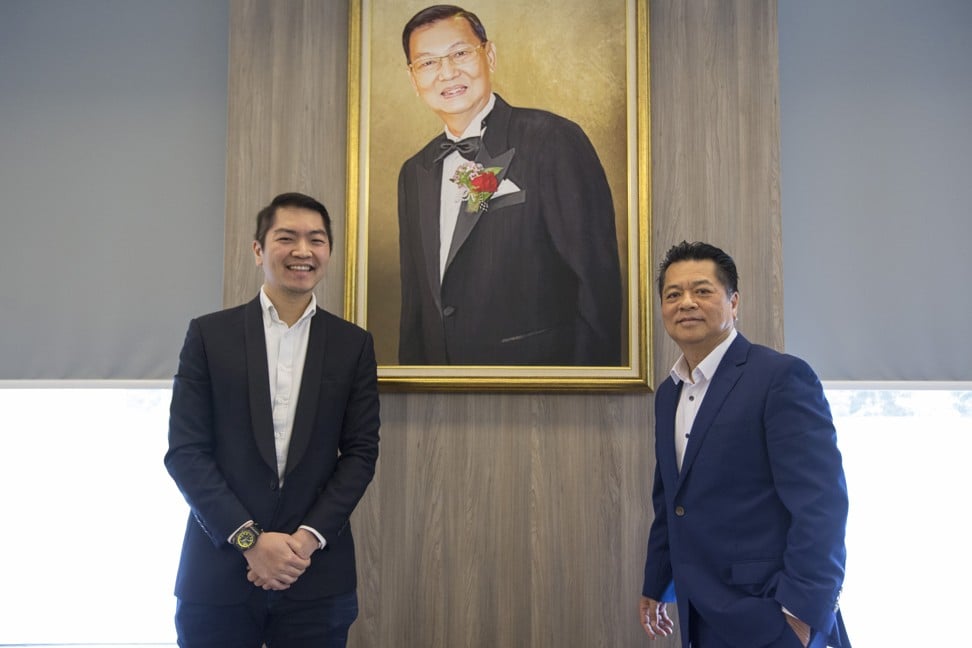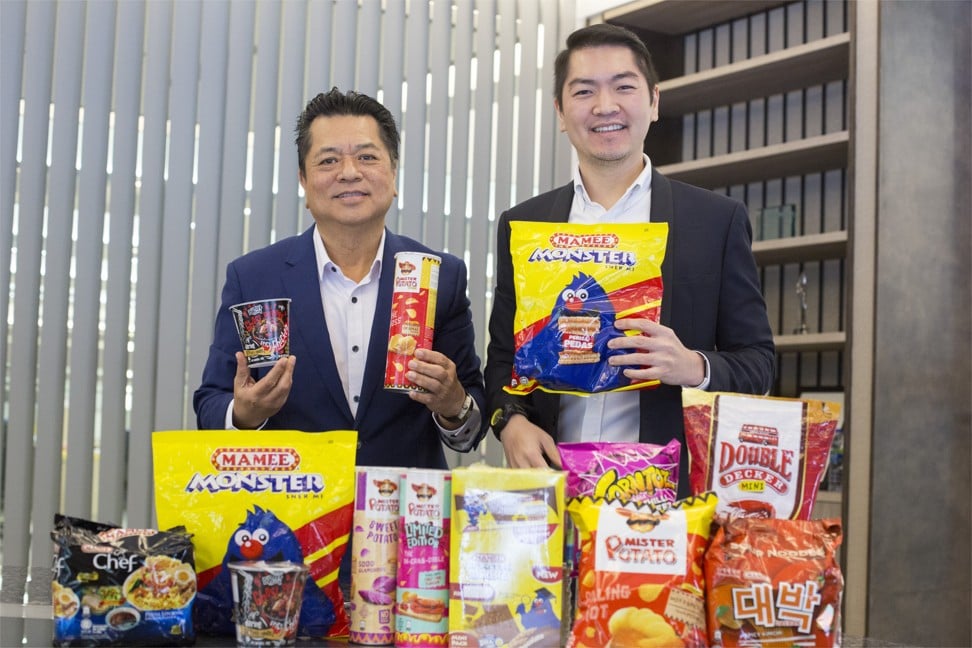
Mamee Monster noodles’ story – the Malaysian childhood snack that was no instant success
- For 45 years, Mamee noodles have remained close to the hearts of countless Malaysians, instantly bringing back fond childhood memories
- The idea to create a dry noodle snack came off the back of a trip to a rural Malaysian village in the 1970s
Before Snapchat, Instagram and YouTube, television was the main source of entertainment for children of the 1980s and ’90s. After-school specials and weekend cartoons containing catchy commercials for snacks and toys kept children glued to their television screens.
One character in particular captured the imagination of young Malaysians – a large, blue monster. Far from being scary, the furry Mamee noodle monster burrowed its way into the hearts of many youngsters thanks to the unusual television commercials.
It created such a phenomenon that a new way of snacking was born: eating dry noodles straight out of the packet. Four decades on, this practice is still considered unique enough to warrant an article in New York Magazine and create demand in markets such as China, where Mamee Monster Noodles are not even officially available.
And it all began with a stroke of luck.
In 1971, the newly formed Pacific Food Products company, located in the Malaysian city of Malacca, launched its first creation: Lucky Instant Noodle. Since it was the fourth brand of instant noodles made available in the Malaysian market, however, the product received only a lukewarm response.
So company founder Pang Chin Hin and his son, Pang Tee Chew, had to find a way to turn around their struggling business.
How Singapore’s Bee Cheng Hiang grew into an Asian powerhouse
During a trip to a rural village, Tee Chew saw farm workers eating dry instant noodles straight from the packet, and he had a light-bulb moment.
“I came up with the noodle snack idea. My father is a very savvy person, so he worked out a way to season the noodles, while I marketed the finished product, aiming it at kids. The Mamee name and the blue monster mascot were chosen because they are easy to remember,” he says.
“We put the product in small packets to keep them affordable. We stopped production of the Lucky noodles immediately after Mamee Monster became a hit.”
But Mamee Monster Noodles, launched in 1974, proved popular not only among youngsters but also adults from all walks of life, thanks to its rich flavour, strong marketing strategy and widespread availability. It ultimately redeemed the failure of Lucky, becoming Malaysia’s bestselling noodle snack in the 1980s.

The company, which officially changed its name to Mamee-Double Decker in 1992, maintained its momentum by later inventing and launching more products, such as Double Decker crackers and Mister Potato – now the bestselling potato crisp brand in Malaysia.
Snack foods are often thought of as unhealthy, or full of artificial flavours and ingredients, but the producers of Mamee-Double Decker have made it their mission to change perceptions of their products by, for example, opening its factories and showing visitors the step-by-step production process for the Mamee snacks and instant noodles.
The Pang family take pride in their efforts to produce “healthy” goods, and point out that Mamee only uses genuine chicken stock for seasoning and refuses to add any wax to their products, unlike some of their competitors.

At its main factory in Malacca, the company employs the latest technology to ensure the quality of the products remain consistent. Robots have taken over most of the manual work in the factory, with a target to reduce the workforce by 20 per cent annually.
As a family business, Mamee-Double Decker is now in its fourth generation. Chin Hin’s grandson, Pierre Pang, is now director of sales and marketing.
He recalls: “I definitely ate a lot of Mamee Monster snacks as a kid. My grandfather and father would never launch products that the kids in our family wouldn’t eat. We were the target market back then. That was how I came to understand that Mamee is a family business. We even talked about it at the dinner table ... the business has created a strong family bond between us.”

The company now makes more than 50 different products and Mister Potato crisps are its biggest seller, but Mamee Monster snacks remain close to the hearts of countless Malaysians, instantly bringing back fond childhood memories after being on the market for 45 years.
The makers of Mamee, however, refuse to live in the past. The company continues to push the boundaries of brand experience, especially at a time when consumers are using media in new ways.
Aware of changes in consumer habits, Mamee continues to innovate through market research. It has set up its own research team, the Monster Lab, which works in parallel with the company’s research and development arm to collaborate with consumers through focus groups.

As the young face of the company, Pierre knows that current consumer habits are often driven by psychology rather than the actual quality of the products. So he decided to think outside the box to drive consumer demand.
This is how the Monster Lab team came up with Mamee Daebak Ghost Pepper noodles in collaboration with a South Korean partner. It was sold in limited quantities with hardly any promotion other than the #GhostPepperChallenge hashtag, which went viral on social media this year.

Promoted as the spiciest instant noodles in Malaysia, consumers bought it for the experience, not so much for the taste. Buyers were even paying double the original price for the noodles on the secondary market.
“The [old] television commercial featuring the blue monster won’t have the same impact [now] as it used to. Today’s consumers need to be engaged with brand experience, both digitally and physically,” Pierre says. “And as the 50th anniversary of Mamee Monster noodles approaches, we have a lot of different things planned. There is a movie in the works, as well as a play gym for kids where they can enjoy the complete Mamee Monster experience.”
Although the film and play gym are still in the planning stages, concept store and cafe Mamee Jonker House is already offering Mamee enthusiasts direct interaction with the brand.

Located in the city centre of Malacca, a tourist hotspot, the Mamee centre has drawn visitors from all over the world in the four years since it opened. With a menu made up of Mamee products as well as cutesy merchandise bearing the face of the blue monster, the cafe also organises activities for visitors to make their own Mamee Monster snacks and cup noodles.
“We have been approached by [tech giant] Alibaba [which owns the South China Morning Post] for a collaboration even though we have not done much promotion in China,” Pierre says.
“It came about after their search data revealed that a lot of people had been searching for our products on their online platform. Apart from noodle snacks, Mamee Monster will be marketed as a character on a wide range of products such as biscuits and crisps in China as well as South Korea and Hong Kong. The Mamee Monster will also soon be transformed into a digital celebrity with its own social media accounts,” he adds.

After more than four decades in business, the company has notched up many major milestones, including a partnership with Manchester United Football Club and the opening of a free kidney dialysis centre in Malacca for underprivileged locals.
Mamee is a home-grown icon that has been with Malaysian families for decades. And while it’s nice to look back to the past, the future looks even brighter for everyone’s favourite blue monster.
